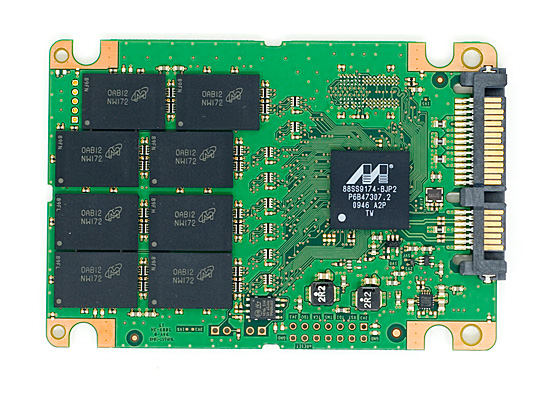6Gbps SATA Performance: AMD 890GX vs. Intel X58/P55
by Anand Lal Shimpi on March 25, 2010 12:00 AM EST- Posted in
- Storage
Final Words
AMD’s ATI acquisition was about bringing graphics to the portfolio with the eventual goal of integration into the CPU itself. We’ll see the first of that early next year with Llano. But as AMD goes down this integration route, it needs to make sure that its chipsets are at least up to par with Intel’s. Many have complained about AMD’s South Bridges in the past, but with SB850 we’ve actually seen some real improvement. There still appear to be some strange behaviors and I don’t like that there’s any discrepancy between AMD’s reference board and retail 890GX boards, but these results look very promising.
AMD’s native 6Gbps implementation manages to outperform both Marvell and Intel’s controllers in the 4KB random write test by a substantial margin. AMD’s sequential read speed is lower than the Marvell controller, and random read speed is lower than Intel’s 3Gbps controller. With a bit of work, AMD looks like it could have the best performing SATA controller on the market.
Intel’s X58 still has a few tricks left up its sleeve - it manages to be a very high performing 3Gbps SATA controller. Other than in sequential read speed, it’s even faster than Marvell’s 6Gbps controller with a 6Gbps SSD - although not by much.

Marvell makes the only 6Gbps SSD controller today. By next year that will change.
The P55 and H55 platforms are far less exciting. Any 6Gbps controller connected off the PCH is severely limited by Intel’s use of PCIe 1.0 slots. Unfortunately this means that you’ll have to use the 16 PCIe 2.0 lanes branching off the CPU for any real performance. That either results in you limiting your GPU to only 8 lanes or dropping back down to PCIe 1.0 if you have two graphics cards installed. ASUS’ PLX solution is an elegant workaround for the specific case of a user having two graphics cards and a 6Gbps SATA controller on-board. Our tests show that it does work well.
We have to give AMD credit here. Its platform group has clearly done the right thing. By switching to PCIe 2.0 completely and enabling 6Gbps SATA today, its platforms won’t be a bottleneck for any early adopters of fast SSDs. For Intel these issues don't go away until 2011 with the 6-series chipsets (Cougar Point) which will at least enable 6Gbps SATA.










57 Comments
View All Comments
Shadowmaster625 - Tuesday, March 30, 2010 - link
It sounds like AMD made a conscious decision to focus on maximum random write performance, even if it required sacrificing all other key performance metrics. I hope that is the case, because it is pretty sad that their 6 gbps controller is generally outperformed by a 3 gbps controller!astewart999 - Tuesday, March 30, 2010 - link
When talking performance, why are they not mentioning RAID 0. I suspect SATA3 is not capable?astewart999 - Tuesday, March 30, 2010 - link
Ignore my ignorance, I read the article then posted. Should have read the posts and ignored the article!nexox - Monday, April 5, 2010 - link
Just get a SASII (6Gbit) PCI-E HBA (LSI makes one, probably others) - plenty of speed, they generally run on a PCI-E 8x slot, and you can run SATA drives in them just fine. Plus they tend not to cost too much more than the consumer-level SATA adaptors, which are apparently questionable performance-wise. They'd at least make a good baseline for comparison.supremelaw - Saturday, April 17, 2010 - link
RS2BL040 and RS2BL080 are now at Newegg:http://www.newegg.com/Product/Product.aspx?Item=N8...
http://www.intel.com/products/server/raid-controll...
http://www.newegg.com/Product/Product.aspx?Item=N8...
http://www.intel.com/products/server/raid-controll...
Before buying, confirm whether or not TRIM will work with SSDs in RAID modes.
http://www.pcper.com/comments.php?nid=8538
*** UPDATE ***
The unconfirmed bit has been confirmed as unconfirmed from Intel:
“Intel® RST 9.6 supports TRIM in AHCI and pass through modes for RAID. A bug has been submitted to change the string that indicates TRIM is supported on RAID volumes (0,1,5,10). Intel is continuing to investigate the ability of providing TRIM support for all RAID volumes in a future release”
Looks like we'll have to wait a little longer for TRIM through RAID, but there *are* other SSD-specific improvements in this new driver.
*** END UPDATE ***
MRFS
chrcoluk - Saturday, June 19, 2010 - link
Ok my thoughts.1 - you written of pcie v1 however failed to notice or mention that the plx chip uses pci-e 1x lanes from the p55 chipset so clearly pci-e 1.0 can supply the bandwidth if utilised properly, the plx chip transfers 4 1.0 lanes into 2 virtual 2.0 lanes for the sata6g and usb3.
2 - some p55 boards, mine noticebly have a pci 2.0 slot fed of the p55 chipset @ x4 speed. Seems reviewers have got something wrong or are they claiming asus have it wrong? Even if we assume its actually pci 1.0 x4 that is still enough bandwidth to feed a sata 6g controller. Indeed the onboard plx which you praised sacrifices this x4 pci-e slot and uses those 4 lanes to feed itself. My thoery is the U3S6 card asus sell will perform the same as the onboard plx in a x4 slot but no reviewer has tested this properly.
3 - whats the reason you did not test both gigabytes onboard and the lower asus onboard which borrow bandwidth from the primary pci-e x16 lanes, I am looking for tests of those in both turbo/levelup and normal mode.
gimespace - Tuesday, August 8, 2017 - link
Try enabling DirectGMA with maximum GPU Aperture in Amd catalyst control center. It does not only make the graphics card faster but allowed me to get up to the maximum 560mb/s read speed for my ssd!